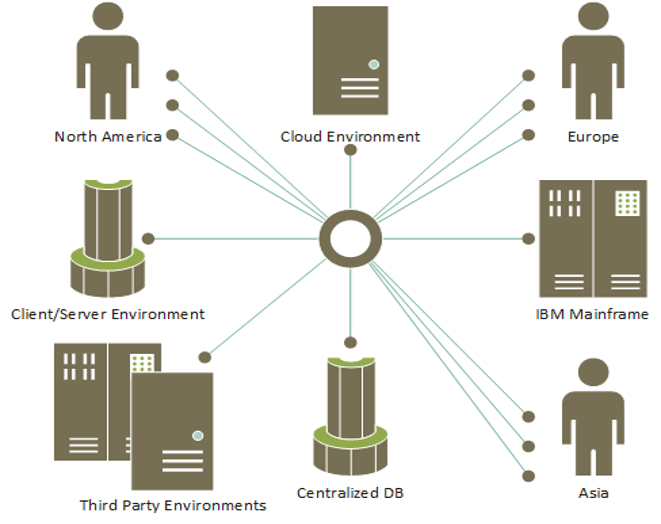Use Agentic AI to generate smarter API tests. In minutes. Learn how >>
Reading Time: 4 minutes
Jump to Section
Overview
The wealth management firm is a subsidiary of a complete financial services company that has a multi-national presence with hundreds of branches in Canada and the United States, plus offices in 36 other countries, serving more than 16 million customers around the world.
The firm’s senior QE manager for test data management in the technology and services team supports the global team of developers and testers to work productively and collaboratively on these applications across various time zones.
Jump to Section
The Challenges
Global organizations must deal with the complexities of doing business around the clock. There’s no time zone available for downtime. With offices and teams across multiple continents that all require access to the same service for testing purposes, it’s a challenge to schedule batch runs that take that service offline to prevent unplanned updates and data pulls. If this service isn’t available, their other applications won’t load, and testing becomes stalled.
Multiple Technology Stacks
One of the firm’s main challenges is working with multiple technology stacks.
These include:
- Client-server environments (Oracle and SQL)
- Centralized databases
- An IBM mainframe
- Expanding cloud environments
The QE manager explained that they needed to manage the integration of each of these different environments and make sure data moves between all of them. Plus, all systems needed to be available and to communicate with each other.
Time Zones
Another large issue was time differences. Branches are located in various time zones across the world. In addition, the firm has thousands of people working from home, also in different zones. Some groups and individuals reside in North America, while the company has development teams and QE in Europe and Asia, too.
Their challenge was to make sure the system could handle performance testing, unit testing, functional testing, and automated testing at any time of the day.
Multiple Projects
Because the firm has different applications within each of their diverse environments, each application may have multiple projects going on. Each of these different groups connects with multiple small groups within them, connecting to the same environment, and they all stumble over one another.

Because the firm has different applications within each of their diverse environments, each application may have multiple projects going on. Each of these different groups connects with multiple small groups within them, connecting to the same environment, and they all stumble over one another.
Impact on Time & Cost
When all of this works together, it’s great. But what about when it doesn’t?
In the firm’s situation, one of their key third parties had batch processing scheduled between 3 and 4 a.m. ET. (Banks collect large amounts of information and data in batches over a certain amount of time and then process it and produce the results. This is in contrast to real-time processing where companies process data immediately, one transaction at a time.) The 3 to 4 a.m. timeframe is early hours for North America but right in the middle of the day for Europe and even later in the day for Asia.
Some days, processing extended substantially beyond that window, sometimes lasting for as long as four hours. That’s four hours out of an eight-hour day where the system was not available.
This was time the firm was paying for but during which the company was unable to process a single test or do anything else. The company could have built its own test cases and documentation and prepared for when the company had access to the environment. But they had no guarantees as to when the environment would be available.
The result was a huge impact on time and cost of delivery. Transactions were taking longer than they should have taken, and also cost more because basically, they were working half days.
The Approach
The firm’s technical team worked directly with the Parasoft team to find a solution to their challenges. First, the firm identified all of the key touch points within this context that it could simulate. The idea was, “Okay, if an environment is not available, let’s see if we can make it appear to be available.” This led the firm to consider service virtualization.
To avoid causing downtime issues, the team simulated the availability of the critical application so that multiple applications downstream could continue testing. By eliminating testing delays due to environment outages, their teams could execute tests more consistently and plan more efficiently for performance, penetration, and regression testing. This resulted in lower costs for the development and test teams and enabled them to meet schedule targets.
The Solution
To determine what solution they needed, the firm performed a bunch of test cases—use case scenarios. They determined that service virtualization would enable their global teams to continue working across time zones without any downtime affecting their testing. The Parasoft solution provided the capabilities they needed more effectively than the competition with a compelling price point.
The Results
The QE manager and his team received concrete benefits by getting in touch with a Parasoft software test automation expert at the onset and absorbing what the Parasoft team suggested. The firm discovered that the Parasoft team has many skills and much knowledge and experience to provide valuable guidance.
“A problem or issue may be new to your team, but Parasoft has most likely seen it before.”
—Senior QE manager for test data management at the firm
In regard to the firm’s geographic challenges, they can now enable development teams in other regions to turn on the service virtualization environment and simulate data on demand, so their application testing continues even during live environment outages.
Benefits the Firm Experienced
- Reduced delivery time. The firm eliminated testing delays with virtualization.
- Reduced labor cost and less downtime. The firm was able to avoid the unnecessary rework that unavailable endpoints or data often cause, and their productivity increased as they improved testing consistency.
- A more flexible virtual environment. The firm felt that with Parasoft, they were in control for switching between real and virtual services so they could continuously test.
- Better system availability. The firm improved planning for performance and security testing and achieved more thorough testing.
- Testing earlier. The firm got development involved in testing to shift it to the left, enabling earlier identification of potential issues.
- Reduced project costs. Parasoft Virtualize eliminated environment downtime, which, in turn, eliminated project delivery delays and minimized project cost overruns. Additionally, the team produced better quality results.
Summary
The wealth management firm’s next steps are to keep expanding the use of the tool, to continue building their strategy, and to continue building out their continuous quality approach. They understand that this is not a one-and-done situation.
The QE Manager and his team admit that other vendors and options exist with other ways of doing things. But based on their scenario, working with Parasoft was the best solution, the one they ultimately chose, and the one that they continue to build on.
Learn the critical features and key capabilities to look for in a service virtualization solution to maximize return on investment.
- Industry: Finance
- Company Size: 97,000
- Location: Toronto, Canada
- Solution: Virtualize


